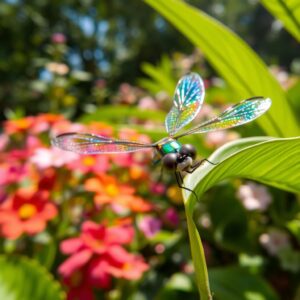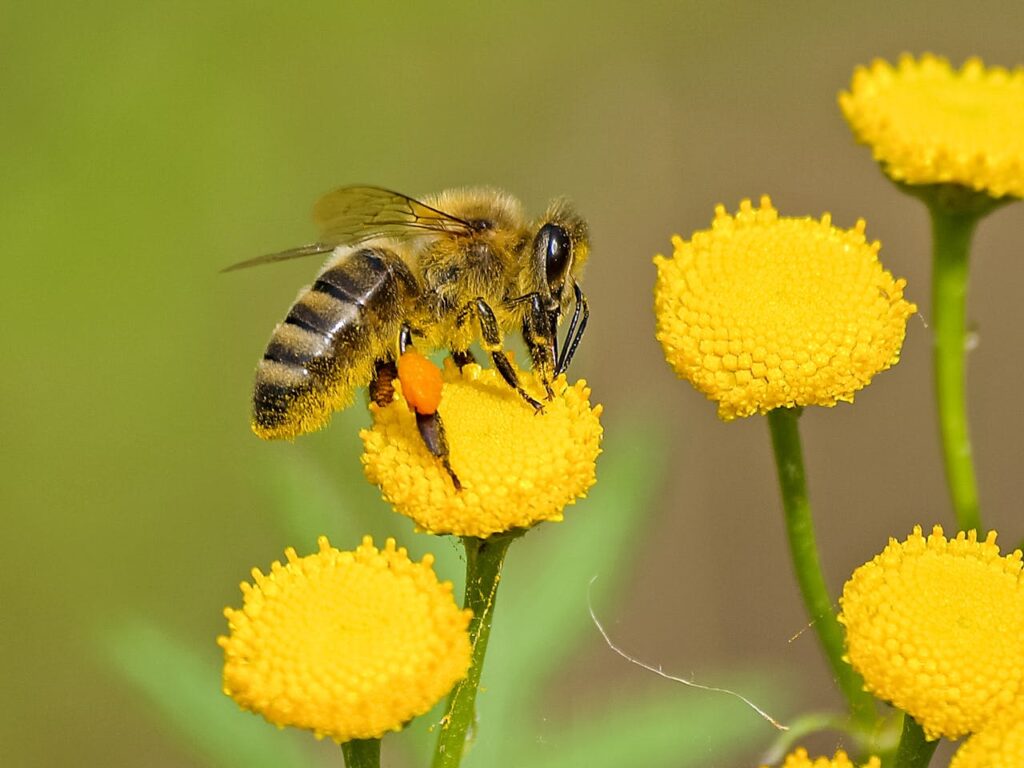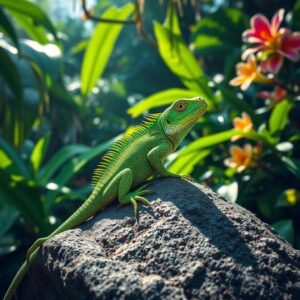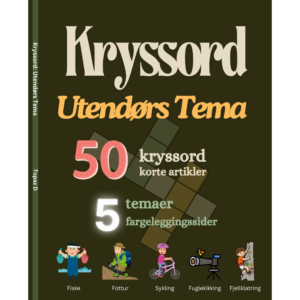
Explore & Play
Discover interesting topics and solve the accompanying crossword puzzle.
Insect Crossword | Fascinating Facts about Insects
Test your knowledge with our Insect Crossword and explore our article on fascinating insect roles in nature. Discover the diversity and importance of these tiny creatures
Table of Contents
Welcome to our exploration of the insect world! Before diving into the article, you have the option to test your knowledge with our Insect Crossword. It’s a fun way to challenge yourself and learn more about these fascinating creatures. If you’re not yet familiar with the topic, feel free to start by reading the article to gain a deeper understanding, and then return to the Insect Crossword to reinforce your new knowledge. Enjoy the journey into the amazing world of insects!
Insect Crossword
You can either fill in the crossword puzzle directly on this page or click the button in the bottom right corner to print it for free.

A World of Insects: Fascinating Creatures and Their Unique Roles in Nature
Insects are some of the most diverse and fascinating creatures on our planet, playing crucial roles in ecosystems and impacting our daily lives in ways we may not even realize. With over a million known species, these tiny yet mighty beings demonstrate incredible adaptability and resilience. From pollinating our crops to controlling pests, insects are indispensable to maintaining ecological balance. In this article, we will explore the unique characteristics and behaviors of various insects, shedding light on their significance in nature. For those who enjoy a challenge, try out our “Insect Crossword” to test your knowledge and learn even more about these captivating creatures!
1. The Incredible Diversity of Insects
From the buzzing bee in your garden to the mysterious glow of a firefly at night, the insect world is brimming with variety and wonder. With millions of species spread across every continent, insects have evolved in astonishing ways to thrive in nearly every environment on Earth.
Consider the praying mantis — a master of stealth and precision. With its distinctive posture, long front legs folded as if in prayer, the mantis patiently waits for its prey. Or think about the stick insect, a marvel of mimicry, whose body resembles a twig or leaf to avoid detection by predators. Even the less known velvet ant, which is actually a wasp, surprises with its velvety appearance and painful sting.
Each insect is unique, showcasing a wide array of adaptations that help them survive, reproduce, and thrive in their environments.
1. The Incredible Diversity of Insects
From the buzzing bee in your garden to the mysterious glow of a firefly at night, the insect world is brimming with variety and wonder. With millions of species spread across every continent, insects have evolved in astonishing ways to thrive in nearly every environment on Earth.
Consider the praying mantis — a master of stealth and precision. With its distinctive posture, long front legs folded as if in prayer, the mantis patiently waits for its prey. Or think about the stick insect, a marvel of mimicry, whose body resembles a twig or leaf to avoid detection by predators. Even the less known velvet ant, which is actually a wasp, surprises with its velvety appearance and painful sting.
Each insect is unique, showcasing a wide array of adaptations that help them survive, reproduce, and thrive in their environments.
2. Social Insects: Masters of Cooperation
Social insects like ants, bees, and termites have complex communities that rival even human societies in organization and efficiency. These insects live in large colonies, where each member has a specific role to play, from the queen responsible for reproduction to the workers who gather food and care for the young.
Take ants, for example. With over 12,000 known species, ants exhibit incredible teamwork and coordination. Some ants are skilled architects, building elaborate underground nests, while others, like leafcutter ants, are industrious farmers, cutting leaves to cultivate fungus for food. Similarly, bees are renowned for their role in pollination, but their social structures are equally fascinating. Within the hive, worker bees communicate through a dance known as the “waggle dance,” indicating the direction and distance of flowers to their fellow bees.
Termites, too, display remarkable cooperation. Though often considered pests, termites play a crucial role in breaking down dead plant material, enriching the soil. Their colonies are highly organized, with a clear division of labor and specialized castes, including soldiers and workers, all working together to sustain their complex societies.
3. Pollinators: The Unsung Heroes of Nature
Without pollinators like butterflies, bees, and moths, our world would look very different — and a lot less colorful. Pollinators are responsible for the reproduction of over 75% of flowering plants, including many fruits, vegetables, and nuts that we rely on for food.
Butterflies are perhaps the most beloved pollinators, flitting from flower to flower and transferring pollen as they go. Their vibrant colors and delicate wings make them a joy to watch, but they are also vital to many ecosystems. Bees, especially honeybees, are arguably the most efficient pollinators, visiting thousands of flowers each day and playing a critical role in agriculture. They are not alone, however; moths also contribute significantly to pollination, especially at night when many flowers open.
Unfortunately, pollinators face numerous threats, including habitat loss, pesticide use, and climate change. Protecting these insects is crucial not just for biodiversity, but for our own food security.
4. Predators and Parasites: Nature’s Balance Keepers
While some insects play friendly roles in nature, others take on the role of predators or parasites, ensuring a delicate balance in the ecosystem. Predatory insects like ladybugs, dragonflies, and wasps are essential for controlling pest populations.
Ladybugs, for example, are voracious eaters of aphids and other small insects that damage crops. Dragonflies are aerial acrobats, hunting mosquitoes, flies, and other small insects in mid-air. Meanwhile, wasps serve dual purposes; they are predators of many garden pests and also act as pollinators.
On the flip side, there are parasitic insects like mosquitoes, fleas, and bedbugs. While often seen as nuisances, these insects play a role in controlling animal populations and contributing to the natural balance. However, they can also spread diseases, affecting both humans and animals.
By keeping insect populations in check, both predators and parasites play crucial roles in maintaining a healthy ecosystem.
5. The Art of Disguise: Insects’ Survival Tactics
Insects have mastered the art of camouflage and deception to survive in a world full of predators and challenges. Many insects rely on their ability to blend into their surroundings, avoiding detection by predators and increasing their chances of survival.
The stick insect is a perfect example, with its slender, twig-like appearance that makes it nearly invisible among branches and leaves. Similarly, the leaf insect mimics the shape and color of a leaf, complete with veins and even spots that resemble insect bites. Another fascinating example is the hoverfly, which mimics the appearance of a bee or wasp to deter predators.
Beyond camouflage, some insects have developed unique defense mechanisms. The stink bug, for example, releases a foul odor when threatened, deterring predators. These adaptations show just how innovative and resourceful insects can be when it comes to survival.
6. The Oddities of the Insect World: Strange and Surprising Behaviors
The insect world is full of strange, surprising, and sometimes even humorous behaviors that are key to their survival. For instance, the dung beetle has a peculiar habit of rolling dung into balls and burying it underground. This behavior not only provides food for themselves and their larvae but also helps recycle nutrients back into the soil.
Leafcutter ants exhibit another fascinating behavior; they cut leaves into small pieces and carry them back to their nests. However, they do not eat the leaves; instead, they use them to cultivate fungus, which serves as their primary food source. Then, there’s the mesmerizing mating dance of fireflies, where males light up the night sky in a bid to attract females. Similarly, the glowworm uses bioluminescence to lure prey into its sticky traps.
These behaviors, although peculiar, serve vital functions that help insects thrive in their respective environments.
7. Insects as Pests: The Double-Edged Sword
While insects play many beneficial roles, some species are infamous for their nuisance and damage. Common pest insects like cockroaches, flies, mosquitoes, and locusts can be problematic for both humans and the environment.
Cockroaches are notorious for spreading diseases and causing allergies, while flies are vectors for a range of pathogens. Mosquitoes are perhaps the most dangerous, responsible for spreading diseases like malaria, dengue, and Zika virus. Locusts, on the other hand, can devastate crops in swarms, leading to significant agricultural losses.
However, even these pests have their place in the ecosystem. For example, they provide food for predators like the praying mantis and ladybugs, contributing to the intricate balance of nature.
8. Insects as Food: A Sustainable Protein Source
Around the world, insects have long been a source of nutrition, offering a sustainable and environmentally friendly protein option. For many cultures, insects like crickets and mealworms are a staple food, providing a rich source of protein, vitamins, and minerals.
In recent years, there has been growing interest in insect-based foods as a sustainable alternative to traditional livestock. Insects require less land, water, and feed compared to cattle, and they produce fewer greenhouse gases. Embracing insects as food could be a key step towards a more sustainable future.
9. Insects in Folklore and Culture
Insects have not only shaped our environment but also our stories, myths, and cultural practices throughout history. The scarab beetle, for example, was a symbol of renewal and protection in ancient Egyptian mythology. In various cultures, butterflies represent transformation, while crickets are considered symbols of good luck and prosperity.
These cultural associations highlight the deep connection between humans and insects, reflecting the many ways these tiny creatures have influenced our beliefs and traditions.
10. Conservation of Insects: Why It Matters
Despite their size, insects are among the most important organisms on Earth, and conserving them is crucial for our planet’s health. Insects face numerous threats, including habitat destruction, pollution, and climate change. Protecting these small creatures is vital not only for maintaining biodiversity but also for the countless services they provide, from pollination to pest control.
By understanding and appreciating the importance of insects, we can take steps to protect them and ensure that they continue to play their essential roles in our world.
Final Thoughts: The Marvel of the Insect World
From the tiniest ants to the most vibrant butterflies, insects are truly fascinating creatures that play vital roles in our world. They may be small, but their impact is immense, influencing everything from the food we eat to the health of our ecosystems. Next time you see a bee buzzing by or a beetle scuttling along, take a moment to appreciate the incredible diversity and importance of these tiny marvels. And don’t forget to challenge yourself with our “Insect Crossword” to test your newfound knowledge!
3. Pollinators: The Unsung Heroes of Nature
Without pollinators like butterflies, bees, and moths, our world would look very different — and a lot less colorful. Pollinators are responsible for the reproduction of over 75% of flowering plants, including many fruits, vegetables, and nuts that we rely on for food.
Butterflies are perhaps the most beloved pollinators, flitting from flower to flower and transferring pollen as they go. Their vibrant colors and delicate wings make them a joy to watch, but they are also vital to many ecosystems. Bees, especially honeybees, are arguably the most efficient pollinators, visiting thousands of flowers each day and playing a critical role in agriculture. They are not alone, however; moths also contribute significantly to pollination, especially at night when many flowers open.
Unfortunately, pollinators face numerous threats, including habitat loss, pesticide use, and climate change. Protecting these insects is crucial not just for biodiversity, but for our own food security.
4. Predators and Parasites: Nature’s Balance Keepers
While some insects play friendly roles in nature, others take on the role of predators or parasites, ensuring a delicate balance in the ecosystem. Predatory insects like ladybugs, dragonflies, and wasps are essential for controlling pest populations.
Ladybugs, for example, are voracious eaters of aphids and other small insects that damage crops. Dragonflies are aerial acrobats, hunting mosquitoes, flies, and other small insects in mid-air. Meanwhile, wasps serve dual purposes; they are predators of many garden pests and also act as pollinators.
On the flip side, there are parasitic insects like mosquitoes, fleas, and bedbugs. While often seen as nuisances, these insects play a role in controlling animal populations and contributing to the natural balance. However, they can also spread diseases, affecting both humans and animals.
By keeping insect populations in check, both predators and parasites play crucial roles in maintaining a healthy ecosystem.
5. The Art of Disguise: Insects’ Survival Tactics
Insects have mastered the art of camouflage and deception to survive in a world full of predators and challenges. Many insects rely on their ability to blend into their surroundings, avoiding detection by predators and increasing their chances of survival.
The stick insect is a perfect example, with its slender, twig-like appearance that makes it nearly invisible among branches and leaves. Similarly, the leaf insect mimics the shape and color of a leaf, complete with veins and even spots that resemble insect bites. Another fascinating example is the hoverfly, which mimics the appearance of a bee or wasp to deter predators.
Beyond camouflage, some insects have developed unique defense mechanisms. The stink bug, for example, releases a foul odor when threatened, deterring predators. These adaptations show just how innovative and resourceful insects can be when it comes to survival.
6. The Oddities of the Insect World: Strange and Surprising Behaviors
The insect world is full of strange, surprising, and sometimes even humorous behaviors that are key to their survival. For instance, the dung beetle has a peculiar habit of rolling dung into balls and burying it underground. This behavior not only provides food for themselves and their larvae but also helps recycle nutrients back into the soil.
Leafcutter ants exhibit another fascinating behavior; they cut leaves into small pieces and carry them back to their nests. However, they do not eat the leaves; instead, they use them to cultivate fungus, which serves as their primary food source. Then, there’s the mesmerizing mating dance of fireflies, where males light up the night sky in a bid to attract females. Similarly, the glowworm uses bioluminescence to lure prey into its sticky traps.
These behaviors, although peculiar, serve vital functions that help insects thrive in their respective environments.
7. Insects as Pests: The Double-Edged Sword
While insects play many beneficial roles, some species are infamous for their nuisance and damage. Common pest insects like cockroaches, flies, mosquitoes, and locusts can be problematic for both humans and the environment.
Cockroaches are notorious for spreading diseases and causing allergies, while flies are vectors for a range of pathogens. Mosquitoes are perhaps the most dangerous, responsible for spreading diseases like malaria, dengue, and Zika virus. Locusts, on the other hand, can devastate crops in swarms, leading to significant agricultural losses.
However, even these pests have their place in the ecosystem. For example, they provide food for predators like the praying mantis and ladybugs, contributing to the intricate balance of nature.
8. Insects as Food: A Sustainable Protein Source
Around the world, insects have long been a source of nutrition, offering a sustainable and environmentally friendly protein option. For many cultures, insects like crickets and mealworms are a staple food, providing a rich source of protein, vitamins, and minerals.
In recent years, there has been growing interest in insect-based foods as a sustainable alternative to traditional livestock. Insects require less land, water, and feed compared to cattle, and they produce fewer greenhouse gases. Embracing insects as food could be a key step towards a more sustainable future.
9. Insects in Folklore and Culture
Insects have not only shaped our environment but also our stories, myths, and cultural practices throughout history. The scarab beetle, for example, was a symbol of renewal and protection in ancient Egyptian mythology. In various cultures, butterflies represent transformation, while crickets are considered symbols of good luck and prosperity.
These cultural associations highlight the deep connection between humans and insects, reflecting the many ways these tiny creatures have influenced our beliefs and traditions.
10. Conservation of Insects: Why It Matters
Despite their size, insects are among the most important organisms on Earth, and conserving them is crucial for our planet’s health. Insects face numerous threats, including habitat destruction, pollution, and climate change. Protecting these small creatures is vital not only for maintaining biodiversity but also for the countless services they provide, from pollination to pest control.
By understanding and appreciating the importance of insects, we can take steps to protect them and ensure that they continue to play their essential roles in our world.
Final Thoughts: The Marvel of the Insect World
From the tiniest ants to the most vibrant butterflies, insects are truly fascinating creatures that play vital roles in our world. They may be small, but their impact is immense, influencing everything from the food we eat to the health of our ecosystems. Next time you see a bee buzzing by or a beetle scuttling along, take a moment to appreciate the incredible diversity and importance of these tiny marvels. And don’t forget to challenge yourself with our “Insect Crossword” to test your newfound knowledge!
5. The Art of Disguise: Insects’ Survival Tactics
Insects have mastered the art of camouflage and deception to survive in a world full of predators and challenges. Many insects rely on their ability to blend into their surroundings, avoiding detection by predators and increasing their chances of survival.
The stick insect is a perfect example, with its slender, twig-like appearance that makes it nearly invisible among branches and leaves. Similarly, the leaf insect mimics the shape and color of a leaf, complete with veins and even spots that resemble insect bites. Another fascinating example is the hoverfly, which mimics the appearance of a bee or wasp to deter predators.
Beyond camouflage, some insects have developed unique defense mechanisms. The stink bug, for example, releases a foul odor when threatened, deterring predators. These adaptations show just how innovative and resourceful insects can be when it comes to survival.
6. The Oddities of the Insect World: Strange and Surprising Behaviors
The insect world is full of strange, surprising, and sometimes even humorous behaviors that are key to their survival. For instance, the dung beetle has a peculiar habit of rolling dung into balls and burying it underground. This behavior not only provides food for themselves and their larvae but also helps recycle nutrients back into the soil.
Leafcutter ants exhibit another fascinating behavior; they cut leaves into small pieces and carry them back to their nests. However, they do not eat the leaves; instead, they use them to cultivate fungus, which serves as their primary food source. Then, there’s the mesmerizing mating dance of fireflies, where males light up the night sky in a bid to attract females. Similarly, the glowworm uses bioluminescence to lure prey into its sticky traps.
These behaviors, although peculiar, serve vital functions that help insects thrive in their respective environments.
7. Insects as Pests: The Double-Edged Sword
While insects play many beneficial roles, some species are infamous for their nuisance and damage. Common pest insects like cockroaches, flies, mosquitoes, and locusts can be problematic for both humans and the environment.
Cockroaches are notorious for spreading diseases and causing allergies, while flies are vectors for a range of pathogens. Mosquitoes are perhaps the most dangerous, responsible for spreading diseases like malaria, dengue, and Zika virus. Locusts, on the other hand, can devastate crops in swarms, leading to significant agricultural losses.
However, even these pests have their place in the ecosystem. For example, they provide food for predators like the praying mantis and ladybugs, contributing to the intricate balance of nature.
8. Insects as Food: A Sustainable Protein Source
Around the world, insects have long been a source of nutrition, offering a sustainable and environmentally friendly protein option. For many cultures, insects like crickets and mealworms are a staple food, providing a rich source of protein, vitamins, and minerals.
In recent years, there has been growing interest in insect-based foods as a sustainable alternative to traditional livestock. Insects require less land, water, and feed compared to cattle, and they produce fewer greenhouse gases. Embracing insects as food could be a key step towards a more sustainable future.
9. Insects in Folklore and Culture
Insects have not only shaped our environment but also our stories, myths, and cultural practices throughout history. The scarab beetle, for example, was a symbol of renewal and protection in ancient Egyptian mythology. In various cultures, butterflies represent transformation, while crickets are considered symbols of good luck and prosperity.
These cultural associations highlight the deep connection between humans and insects, reflecting the many ways these tiny creatures have influenced our beliefs and traditions.
10. Conservation of Insects: Why It Matters
Despite their size, insects are among the most important organisms on Earth, and conserving them is crucial for our planet’s health. Insects face numerous threats, including habitat destruction, pollution, and climate change. Protecting these small creatures is vital not only for maintaining biodiversity but also for the countless services they provide, from pollination to pest control.
By understanding and appreciating the importance of insects, we can take steps to protect them and ensure that they continue to play their essential roles in our world.
Final Thoughts: The Marvel of the Insect World
From the tiniest ants to the most vibrant butterflies, insects are truly fascinating creatures that play vital roles in our world. They may be small, but their impact is immense, influencing everything from the food we eat to the health of our ecosystems. Next time you see a bee buzzing by or a beetle scuttling along, take a moment to appreciate the incredible diversity and importance of these tiny marvels. And don’t forget to challenge yourself with our “Insect Crossword” to test your newfound knowledge!
7. Insects as Pests: The Double-Edged Sword
While insects play many beneficial roles, some species are infamous for their nuisance and damage. Common pest insects like cockroaches, flies, mosquitoes, and locusts can be problematic for both humans and the environment.
Cockroaches are notorious for spreading diseases and causing allergies, while flies are vectors for a range of pathogens. Mosquitoes are perhaps the most dangerous, responsible for spreading diseases like malaria, dengue, and Zika virus. Locusts, on the other hand, can devastate crops in swarms, leading to significant agricultural losses.
However, even these pests have their place in the ecosystem. For example, they provide food for predators like the praying mantis and ladybugs, contributing to the intricate balance of nature.
8. Insects as Food: A Sustainable Protein Source
Around the world, insects have long been a source of nutrition, offering a sustainable and environmentally friendly protein option. For many cultures, insects like crickets and mealworms are a staple food, providing a rich source of protein, vitamins, and minerals.
In recent years, there has been growing interest in insect-based foods as a sustainable alternative to traditional livestock. Insects require less land, water, and feed compared to cattle, and they produce fewer greenhouse gases. Embracing insects as food could be a key step towards a more sustainable future.
9. Insects in Folklore and Culture
Insects have not only shaped our environment but also our stories, myths, and cultural practices throughout history. The scarab beetle, for example, was a symbol of renewal and protection in ancient Egyptian mythology. In various cultures, butterflies represent transformation, while crickets are considered symbols of good luck and prosperity.
These cultural associations highlight the deep connection between humans and insects, reflecting the many ways these tiny creatures have influenced our beliefs and traditions.
10. Conservation of Insects: Why It Matters
Despite their size, insects are among the most important organisms on Earth, and conserving them is crucial for our planet’s health. Insects face numerous threats, including habitat destruction, pollution, and climate change. Protecting these small creatures is vital not only for maintaining biodiversity but also for the countless services they provide, from pollination to pest control.
By understanding and appreciating the importance of insects, we can take steps to protect them and ensure that they continue to play their essential roles in our world.
Final Thoughts: The Marvel of the Insect World
From the tiniest ants to the most vibrant butterflies, insects are truly fascinating creatures that play vital roles in our world. They may be small, but their impact is immense, influencing everything from the food we eat to the health of our ecosystems. Next time you see a bee buzzing by or a beetle scuttling along, take a moment to appreciate the incredible diversity and importance of these tiny marvels. And don’t forget to challenge yourself with our “Insect Crossword” to test your newfound knowledge!
9. Insects in Folklore and Culture
Insects have not only shaped our environment but also our stories, myths, and cultural practices throughout history. The scarab beetle, for example, was a symbol of renewal and protection in ancient Egyptian mythology. In various cultures, butterflies represent transformation, while crickets are considered symbols of good luck and prosperity.
These cultural associations highlight the deep connection between humans and insects, reflecting the many ways these tiny creatures have influenced our beliefs and traditions.
10. Conservation of Insects: Why It Matters
Despite their size, insects are among the most important organisms on Earth, and conserving them is crucial for our planet’s health. Insects face numerous threats, including habitat destruction, pollution, and climate change. Protecting these small creatures is vital not only for maintaining biodiversity but also for the countless services they provide, from pollination to pest control.
By understanding and appreciating the importance of insects, we can take steps to protect them and ensure that they continue to play their essential roles in our world.
Final Thoughts: The Marvel of the Insect World
From the tiniest ants to the most vibrant butterflies, insects are truly fascinating creatures that play vital roles in our world. They may be small, but their impact is immense, influencing everything from the food we eat to the health of our ecosystems. Next time you see a bee buzzing by or a beetle scuttling along, take a moment to appreciate the incredible diversity and importance of these tiny marvels. And don’t forget to challenge yourself with our “Insect Crossword” to test your newfound knowledge!
Final Thoughts: The Marvel of the Insect World From the tiniest ants to the most vibrant butterflies, insects are truly fascinating creatures that play vital roles in our world. They may be small, but their impact is immense, influencing everything from the food we eat to the health of our ecosystems. Next time you see a bee buzzing by or a beetle scuttling along, take a moment to appreciate the incredible diversity and importance of these tiny marvels. And don’t forget to challenge yourself with our “Insect Crossword” to test your newfound knowledge!
Share to...
Thank you for reading 👋
I hope you enjoy the content.
I hope you enjoy the content.
Want to receive our daily crossword puzzle or article? Subscribe!
You may also be interested in
Share to…
Want to receive our daily crossword puzzle?
-
Jigsaw Puzzles
Trolltunga Abstract Jigsaw Puzzle 250 | 300 | 500 Pieces
kr 348,00 – kr 439,00Price range: kr 348,00 through kr 439,00 Select options This product has multiple variants. The options may be chosen on the product page -
Jigsaw Puzzles
Blue-Eyed Kitten Puzzle Delight 250 | 300 | 500 Pieces
kr 348,00 – kr 439,00Price range: kr 348,00 through kr 439,00 Select options This product has multiple variants. The options may be chosen on the product page -
Jigsaw Puzzles
Whimsical Hamster Jigsaw Puzzle in Watercolor Style 250 | 300 | 500 Brikker
kr 348,00 – kr 439,00Price range: kr 348,00 through kr 439,00 Select options This product has multiple variants. The options may be chosen on the product page

















